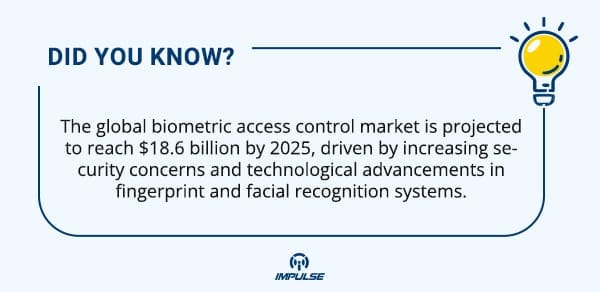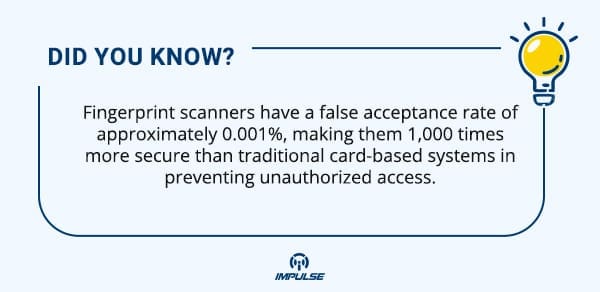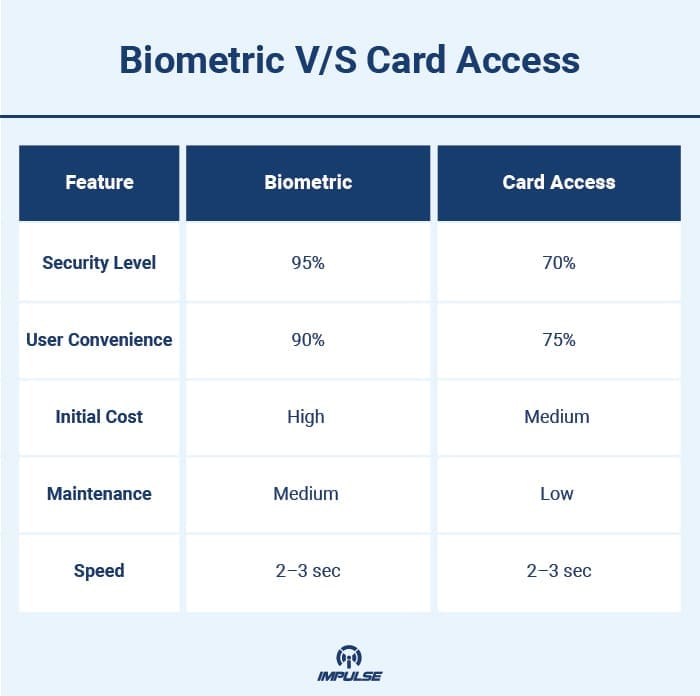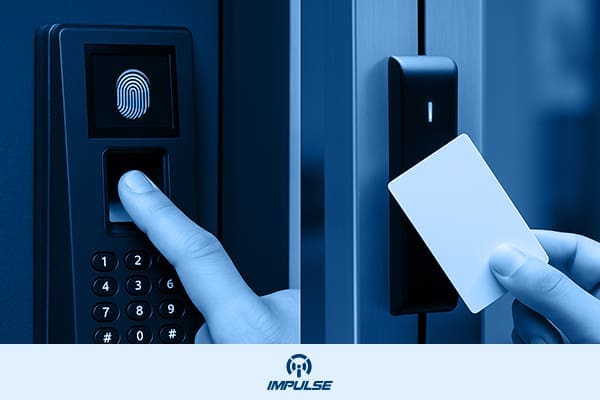Security breaches cost businesses an average of $4.45 million per incident, making robust access control systems essential for protecting your organization’s assets, data, and personnel. When it comes to secure door access control for offices, two primary technologies dominate the market: biometric door access control and card-based access control systems. But which solution truly delivers superior security, convenience, and value for your investment?

Understanding Door Access Control Systems
Door access control systems serve as the first line of defense against unauthorized entry, replacing traditional lock-and-key mechanisms with sophisticated electronic security solutions. These systems authenticate users through various methods before granting or denying access to restricted areas.
Modern access control comparison reveals two leading technologies: biometric systems that authenticate users based on unique physical characteristics like fingerprints, facial features, or iris patterns, and card-based systems that rely on proximity cards, smart cards, or key fobs containing encrypted data.
The Case for Card-Based Access Control
Card-based access control systems have established themselves as reliable workhorses in the security industry. These systems utilize RFID technology, magnetic stripes, or smart card chips to authenticate users. The MIFARE IC Card exemplifies advanced card technology, offering secure contactless data transmission with encrypted initialization and anti-replay protection.
Advantages of Card-Based Systems
Cost-Effectiveness and Scalability Card-based systems typically require lower initial investment compared to biometric alternatives. The RFID Card Reader utilizes advanced RF technology with efficient decoding algorithms, supporting both EM4100 and MIFARE cards while maintaining low power consumption. For organizations managing multiple entry points, the TCP/IP Two Doors Access Control System provides comprehensive management capabilities with multi-computer integration and cloud platform connectivity.
Flexibility and User Management Card systems excel in environments requiring frequent access changes. Lost or stolen cards can be quickly deactivated and replaced without affecting other users. The ID Card Writer enables rapid card programming with fast reading speeds and USB compatibility, eliminating complex driver installations.
Integration Capabilities Modern card-based systems integrate seamlessly with existing security infrastructure. The TCP/IP Four Doors Access Control System offers advanced features including regional interlocking, fire linkage, and dynamic 2D code functionality, making it ideal for comprehensive security implementations.
Limitations of Card-Based Access Control
Despite their advantages, card systems face inherent security vulnerabilities. Cards can be lost, stolen, shared, or cloned by determined attackers. Additionally, users often experience frustration when cards are forgotten, damaged, or demagnetized, leading to productivity disruptions and increased administrative overhead.
The Power of Biometric Door Access Control
Biometric access control systems authenticate users based on unique physiological or behavioral characteristics that cannot be easily replicated, shared, or stolen. These systems offer unparalleled security by ensuring that only authorized individuals can access protected areas.
Benefits of Biometric Systems
Enhanced Security Biometric identifiers are virtually impossible to duplicate, share, or steal. Unlike cards that can be passed between individuals, fingerprints, facial features, and iris patterns remain uniquely tied to their owners, eliminating buddy punching and unauthorized access attempts.
Convenience and Speed Users cannot forget or lose their biometric identifiers, eliminating the frustration associated with forgotten access cards. Modern biometric systems provide rapid authentication, often completing the verification process in less than two seconds.
Audit Trail Accuracy Biometric systems provide irrefutable proof of individual access, creating detailed audit trails that support forensic investigations and compliance requirements. This level of accountability is particularly valuable in high-security environments and regulated industries.
Challenges with Biometric Access Control
Biometric systems require higher initial investment and ongoing maintenance. Environmental factors can affect sensor performance, and some users may experience difficulty with biometric recognition due to physical conditions or age-related changes. Additionally, privacy concerns may arise in certain organizational cultures or regulatory environments.

Access Control Comparison: Technical Considerations
Performance Metrics
When evaluating biometric vs card access systems, consider these critical performance indicators:
Authentication Speed: Modern card readers process credentials in 0.5-1.5 seconds, while advanced biometric systems achieve similar speeds with enhanced security benefits.
Accuracy Rates: Quality biometric systems maintain false rejection rates below 1% and false acceptance rates below 0.1%, significantly outperforming card-based alternatives in security metrics.
Environmental Resilience: The Metal RFID Card Reader (IMP-ACS-MRFCR) demonstrates superior durability with 13.56MHz frequency operation and encryption algorithms, while biometric sensors require protection from extreme temperatures and moisture.
Infrastructure Requirements
Implementing either system requires careful consideration of infrastructure needs. The Access Control Housing with Power Supply Box provides essential power management and housing solutions for access control boards, supporting both card readers and biometric sensors with built-in lock facilities.
Physical installation components like the Switch Panel Door Exit Push Button ensure proper egress control regardless of the authentication method chosen. The durable stainless steel construction withstands heavy usage while maintaining reliable operation.

Best Door Access Control: Hybrid Solutions
Progressive organizations increasingly adopt hybrid approaches combining both technologies. This strategy leverages the convenience and cost-effectiveness of card-based systems while incorporating biometric verification for high-security areas or sensitive operations.
Implementation Strategies
Layered Security Approach Deploy card-based access for general areas while implementing biometric controls for server rooms, executive offices, and sensitive storage areas. This tiered approach optimizes security investment while maintaining operational efficiency.
Backup Authentication Hybrid systems provide redundancy, allowing users to authenticate via alternative methods when primary systems experience technical issues or maintenance requirements.
Which is Better: Biometric or Card Access Control?
The answer depends on your specific security requirements, budget constraints, and operational priorities. Consider these decision factors:
Choose Biometric Systems When:
- Maximum security is paramount
- User accountability is critical
- Long-term operational costs outweigh initial investment
- Environmental conditions support reliable sensor operation
Choose Card-Based Systems When:
- Budget constraints limit initial investment
- Frequent access changes are required
- Users prefer familiar authentication methods
- Integration with existing card-based systems is necessary
Pros and Cons of Biometric Access Control
Advantages
- Unparalleled security through unique identification – Biometric characteristics cannot be duplicated or forged like traditional credentials, providing significantly higher security assurance
- Eliminates card replacement costs and administrative overhead – Organizations save on ongoing expenses related to lost, stolen, or damaged cards while reducing administrative burden
- Provides irrefutable audit trails for compliance – Each access event is linked directly to an individual’s unique biological traits, creating highly reliable records for regulatory requirements
- Prevents credential sharing and unauthorized access – Unlike cards or PINs which can be shared, biometric verification requires the physical presence of authorized individuals
Disadvantages
- Higher initial investment and installation complexity – Biometric systems typically require more sophisticated hardware and software, resulting in greater upfront costs and technical expertise
- Potential privacy concerns in certain environments – Collection and storage of biometric data may raise employee concerns about personal information and require additional compliance measures
- Environmental sensitivity affecting sensor performance – Factors like dirt, moisture, lighting conditions, and temperature can potentially impact the reliability of biometric readers
- Learning curve for users unfamiliar with biometric technology – New users may require training and adjustment period to become comfortable with biometric authentication procedures
Card-Based vs Biometric Access Control System: Making the Right Choice
Your decision should align with organizational security policies, compliance requirements, and user acceptance factors. Consider conducting pilot programs to evaluate user satisfaction and system performance before full-scale deployment.
For comprehensive security implementations, the Double Door Electromagnetic Lock provides robust physical security with 280KG holding force, complementing either authentication technology with reliable locking mechanisms. The epoxy-less design and control PCB mount assembly ensure easy installation and superior performance.
Future-Proofing Your Access Control Investment
Technology evolution continues driving innovation in both biometric and card-based systems. Cloud integration, mobile credentials, and artificial intelligence enhance system capabilities while reducing operational complexity.
Modern access control platforms support multiple authentication methods, enabling organizations to adapt security strategies as requirements evolve. This flexibility protects technology investments while accommodating changing security landscapes.
Secure Your Organization Today
Selecting the optimal door access control system requires careful evaluation of security requirements, operational needs, and budget considerations. Whether you choose biometric door access control, card-based access control, or hybrid solutions, partnering with experienced security professionals ensures successful implementation and ongoing support.
The investment in professional access control systems pays dividends through reduced security incidents, improved operational efficiency, and enhanced regulatory compliance. Don’t compromise your organization’s security with inadequate access control measures.
Impulse CCTV specializes in comprehensive security solutions, offering both biometric and card-based access control systems to protect your assets and personnel.


